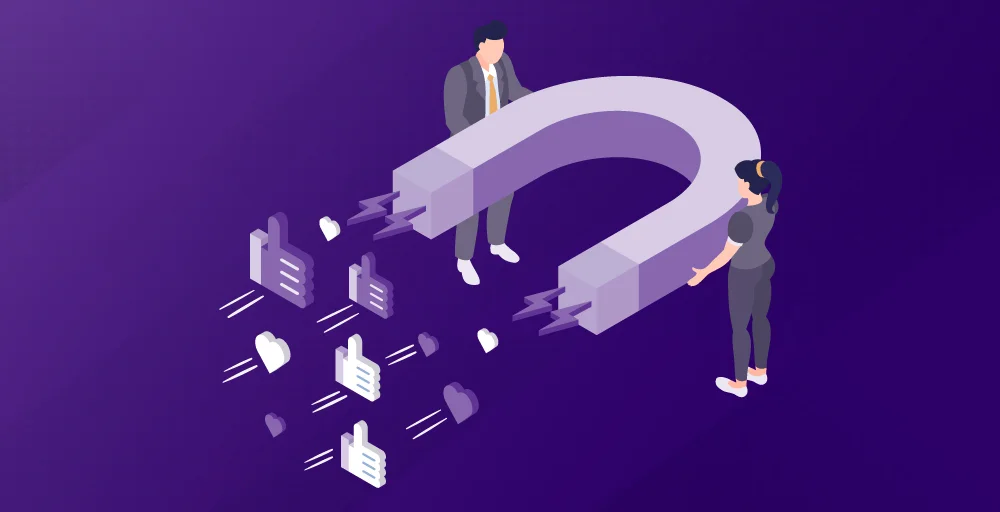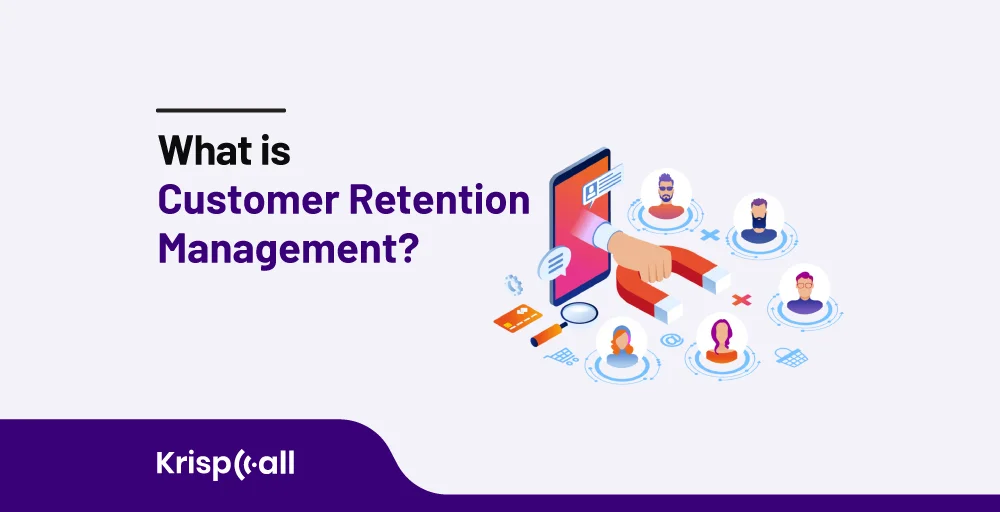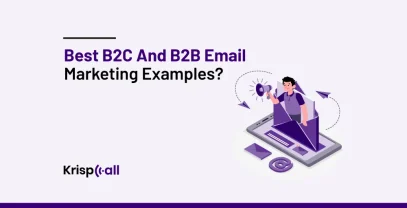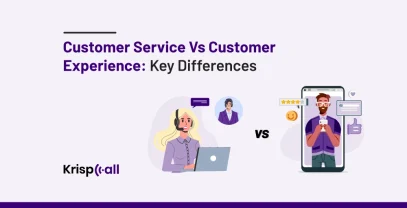Have you ever wondered why companies seem so focused on keeping their existing customers happy?
It’s not just about being nice (although that’s important too!).
Retaining customers is crucial for business success. This is where Customer Retention Management (CRM) comes in. CRM is all about the strategies and practices businesses use to keep their customers loyal and coming back for more.
In this blog, we’ll learn how customer retention management helps you transform happy customers into loyal fans of your business.
🔑 KEY HIGHLIGHTS
- Customer retention management is a strategic approach to keep a long-term relationship with existing customers and enhancing products and services to develop trust and loyalty.
- It is a cost-effective approach for generating stable revenue, improving products, and creating brand loyalty.
- Key elements of customer retention include Customer acquisition, customer retention, customer lifecycle management, and customer development and growth.
- Various well-known brands like Spotify and Amazon use this approach to retain their customers for a long time.
What is Customer Retention Management?
Customer retention management is about keeping your existing customers happy and loyal to your business. It is a strategic approach that involves a variety of actions and programs designed to nurture those relationships.

Effective CRM goes beyond simply providing good service. It’s about to understand your customers and build relationships with them. By focusing on their needs and wants, you can create a positive customer experience that keeps them coming back for more.
It is key to a business’s long-term success.
Why is Customer Retention Management Essential?
Customer retention management is highly essential for business growth and success. It prevents churn and helps to understand what customers expect and what makes them retain.
Customer retention management is essential for the following reasons:
- Generate Stable Revenue: Retention of existing customers ensures stable revenue for the business. Existing customers already know your product, which makes them repeat purchases from you.
- Save Cost: To focus on existing customers is less costly than acquiring new customers. It reduces the marketing and advertising cost of the product to new potential customers.
- Develop Trust and Brand Loyalty: To have loyal customers makes you feel special. Customers stick with you not only because of what you sell, but also because of how you make them feel. That’s something your competitors can’t easily copy.
- Feedback and Improvement: Feedback from existing customers helps you understand the improvement potential of products and services, which in turn helps you improve the products that match your customer needs and preferences.
Key Elements of Customer Retention Management
Customer Retention is essential for business success. A business can save money by retaining existing customers rather than acquiring new ones. Customer retention management includes various key elements.
The key elements of customer retention management include:
1. Customer Acquisition
Customer acquisition is a crucial element in customer retention management. The process starts with the acquisition of the right customers. It involves targeting new potential customers and providing a good customer experience.
Onboarding the wrong customer is not good for a business. It creates a negative impact on customers when their expectations don’t match with the product or service that your company offers. It makes it difficult to retain customers, so acquiring the right customer is a necessary element for customer retention management.
2. Customer Retention
Customer retention means to maintain long-term relationships with existing customers. It includes improving customer experience, building trust, understanding their problems, and keeping them satisfied and loyal for the long term.
Not all customers are beneficial for business, so it is important to know your customers before making efforts to retain them for the long term. The company should use customer data to decide whether they fit your products or services and let them go if there is no profit in keeping them.
3. Customer Lifecycle Management
Customer lifecycle management is another crucial element in customer retention management. It tracks the different touchpoints you attempt to reach potential customers, from initial attempts to brand loyalty.
It is necessary to manage customers according to their preferences and behavior to retain them for a long time. It helps to improve customer experiences.
4. Customer Development and Growth
Customer development and growth are another essential element in improving customer retention. This approach is part of the customer experience and focuses on helping customer satisfaction.
The growing trend of roles like “Customer Success Manager” emphasizes understanding and surpassing customer expectations to keep them satisfied and loyal.
How to Implement a Customer Retention Management System for Your Business?
A customer retention management system is valuable for our business because it improves customer satisfaction and loyalty. However, implementing a customer retention system is hard without proper guidance.
Here are the key steps to implement a customer retention system for your business:
- Identify the right customer fit: Customers retain when they connect with our product and how we interact with them. So, you need to find a product that fits customers who really want your product. It helps to build strong trust and loyalty in a company and increase the rate of retention.
- Set a clear retention goal: Set a clear goal to satisfy and keep customers happy for a long time. Track the number of customers you want to retain for the long term. These goals are like guidance for you; you can change your goal according to the situation.
- Align your teams with product strategy: It is important to ensure that your team understands what makes customers happy and what service they are looking for. It’s also crucial for all departments, like marketing, customer service, and sales, to team up and work towards the same goal of keeping customers satisfied.
Customer Retention Management Example for Different Industries
Many companies prepare a strategy to satisfy existing customers and maintain loyalty to the brand for the long term. Here are some popular brand examples that are able to retain their customers by delivering exceptional customer service.
Some examples are given below:
Example 1
Brand: Spotify
Industry: Entertainment and Media
Spotify, a leading music application, recognizes the significance of customer retention in the competitive entertainment industry. It employs diverse strategies to ensure users remain engaged and subscribed to its service.
Strategy:
Utilizing advanced algorithms, Spotify curates personalized playlists and recommends music tailored to individual user preferences. By analyzing user data and behavior, the platform aims to deliver a unique and customized music experience to each user.
Outcome:
Through its focus on customer retention, Spotify has cultivated a large base of loyal users. Continuous enhancements to its products and the provision of personalized features have solidified Spotify’s position as a premier music streaming service.
Example 2
Brand: Amazon
Industry: E-commerce
Amazon is the world’s largest e-commerce company. It delivers exceptional customer service, which helps it maintain a competitive market. Amazon has millions of monthly active users worldwide.
Strategy:
To retain customers, Amazon offers millions of products on its online platform for audiences with fast delivery. Plus, if customers need help, Amazon offers the convenience of reaching their friendly customer service team by phone, chat, or email, ensuring your shopping experience goes smoothly from start to finish.
Outcome:
By focusing on customer retention through exceptional service, Amazon has built a rock-solid reputation and a legion of loyal customers who keep coming back for more. Their commitment to convenience and satisfaction has set the bar high for the entire e-commerce industry.
Best Customer Retention Management Metrics to Track
There are various ways and methods to find satisfied customers, and these are directly related to customer retention management.
Here are some key metrics to improve customer retention:
Customer retention rate
Customer retention rate measures the percentage of customers who stay with your company over a specific time period. It helps you determine the effectiveness of your loyalty and satisfaction strategies.
Here’s how you can calculate the customer retention rate:
Customer retention rate =Customers at the end of the period – New Customer acquriedCustomers at the Start of the Period*100
Customer churn
This calculates the percentage of customers who discontinue using your service or purchasing your products. This metric helps identify areas for improvement to reduce customer loss.
Formula to calculate customer churn:
Customer churn rate=Customers at the beginning of the period−Customers at the end of the periodCustomers at the beginning of the Period*100
👍To know more about customer churn, read this: Customer Churn: How to Calculate, Predict & Reduce it.
Average revenue per user (ARPU)
This metric calculates the average revenue generated per customer. It helps assess the financial impact of retention efforts.
Formula to calculate average revenue per user:
Average Revenue Per User (ARPU)=Total revenueTotal Number of users
Repeat purchase rate
Repeat purchase rate measures the percentage of customers who have made more than one purchase. It directly indicates repeat business and customer loyalty.
Here’s how you can calculate the repeat purchase rate:
Repeat Purchase Rate (RPR)=Number of Users Making Repeat PurchasesTotal Number of Users*100
5 Best Practices of Customer Retention Management
To be successful at customer retention, you must link your customer data to your bottom line.
Keep that in mind, here are five best practices to make sure your customer retention management works properly:
1. Regular Survey
Regular contact with customers plays a vital role in customer retention management. According to research by Customer Guage, the customer retention rate increased by 51% when quarterly surveys were conducted. Conducting surveys on a regular basis helps to gain valuable insights into changing customer needs and preferences.
2. Increase in Number of Contacts
Taking a large number of contacts in a survey reveals the best results and leads to effective customer retention management. It helps find more ways to make things better and understand what customers want. It not only helps get feedback from large masses but also leads to an increase in the retention rate by 18%.
3. Close the Loop with All Contact
Working on a customer feedback loop creates a positive impact on the customer’s mind. When you receive feedback, you try to take action to improve them. Choosing a loop helps to build trust and loyalty, which increases the customer retention rate.
4. Combine Analysis with Action
After analysis, driven data is essential for improving the overall customer experience and bringing effectiveness in customer retention management. Data obtained from analysis should used to reduce customer churn, increase repeat customers, and retain customers for a long time.
5. Use Retention Metrics
Ultimately, the goal of customer retention management is to generate more sales and increase revenue. The customer retention management program must have a clear impact on revenue. Otherwise, investing in a retention program is a waste.
Conclusion
Customer retention management plays a crucial role in both product development and customer relations. It involves strategies aimed at keeping customers for the long haul and fostering their loyalty.
A well-defined customer retention management in business can reduce marketing costs, increase profitability, and maintain the market share. It aims to produce high-quality products that fit customer needs and demands and continuous improvement of the overall customer experience.
To effectively manage customer retention, consistent surveying, maintaining open communication with all customers, analyzing data to inform actions, and linking retention metrics to revenue generation are vital.
FAQs
What is the customer retention management framework to follow?
The customer retention management framework to follow involves:
- Predicting what makes customers stay
- Implementation of strategies to retain customers
- Delivering exceptional customer experiences
- Monitoring and analyzing customer feedback
- Personalizing interactions
- Continuously adapting and improving efforts to customers understand customers.
Does customer journey mapping enhance customer retention management outcomes?
Yes, customer journey mapping enhances customer retention management outcomes. It helps identify every touchpoint in the customer’s journey.
What are the customer retention management strategies?
Customer retention management strategies include:
- Understanding customer needs
- Offering the best customer experience
- Offer loyalty programs and rewards
- Gathering and improving feedback
- Personalizing interactions
What technologies have transformed customer retention management?
Technologies like CRM software, automation tools, AI-powered platforms, social media integration, and security and privacy tools have transformed customer retention management. These technologies enable a better understanding of customer needs and behaviors.
What are the different types of customer retention management software?
The different types of customer retention management software are:
- HubSpot
- Salesforce
- SurveyMonkey
- Google Analytics
- Marketo
- LoyaltyLion
- Mixpanel





